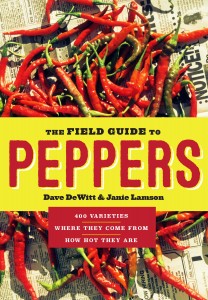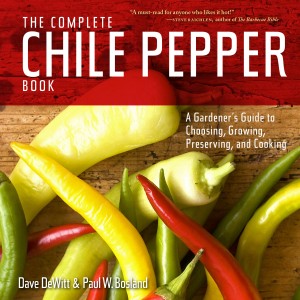From the Library: The Field Guide to Peppers
Posted in From the Library on January 26 2016, by Esther Jackson
Esther Jackson is the Public Services Librarian at NYBG’s LuEsther T. Mertz Library where she manages Reference and Circulation services and oversees the Plant Information Office. She spends much of her time assisting researchers, providing instruction related to library resources, and collaborating with NYBG staff on various projects related to Garden initiatives and events.

307 pp. Timber Press.
The Field Guide to Peppers promises to help readers achieve two things: “to identify unfamiliar pepper varieties … and to assist in the selection of peppers” for inclusion in gardens. Authors Dave DeWitt and Janie Lamson bring extensive expertise and differing strengths to this publication. DeWitt, known to some as the “Pope of Peppers,” has authored over 30 books related to peppers and spicy foods. Lamson, the “Chile Goddess,” is the owner of Cross Country Nurseries in New Jersey and grows and sells all 400 pepper varieties covered in Field Guide.
Field Guide is undeniably attractive even at first glance, with bold and colorful cover art. A quick skim through the book heightens the appeal, bright red pages and accents complementing full-color photos of all 400 peppers. Most readers likely have a favorite pepper, and I found the images of jalapeños to be especially attractive.
While this book is suggested as a tool for both pepper identification and selecting peppers to grow, it seems to be more focused on the latter than the former, as the botanical details are rather limited. However, with the photographs provided, the text could indeed serve as a field guide for the home gardener. The text is helpfully organized by common pepper species—Capsicum annuum, C. baccatum, C. chinense, C. frutescens, and C. pubescens. Capsicum annuum is further divided into pod types, owing to the number of varieties within the group. In terms of selecting peppers for home gardens, this book is especially useful. Comments from the authors accompany each and every pepper, ranging from historical facts to cooking suggestions to alternative names. Origin, pod description, size and color, time of harvest, and heat level are also indicated. Scoville Heat Units (SHU) are the basis of the heat levels defined by the authors (“sweet” to “super hot”), but readers should note that an exact SHU is not given for each pepper.
Reading this book, I occasionally found myself wishing that there was a way for me to isolate peppers based on criteria such as heat level. Field Guide includes a single index of pepper names, but does not index the peppers in any other way. However, Chile Plants, Janie Lamson’s website, allows the pepper enthusiast to search for peppers using 15 criteria—from heat, to color, to season, to species. The site is truly a companion piece to Field Guide and also a source for purchasing all of the 400 varieties described in the print book.

Field Guide is not intended as a gardening guide, although “A Brief Guide to Growing” occupies 10 pages of text toward the start of the book—sans images. DeWitt’s 2014 The Complete Chile Pepper Book (also from Timber Press) is suggested by the authors as a resource for those interested in learning more about growing peppers. The Edible Pepper Garden by Rosalind Creasy is another excellent book on this topic.
All said, The Field Guide to Peppers is both a beautiful and informative work, best supplemented with additional print and electronic resources from both DeWitt and Lamson.


Excellent and interesting reading!
Thank you, Esther.